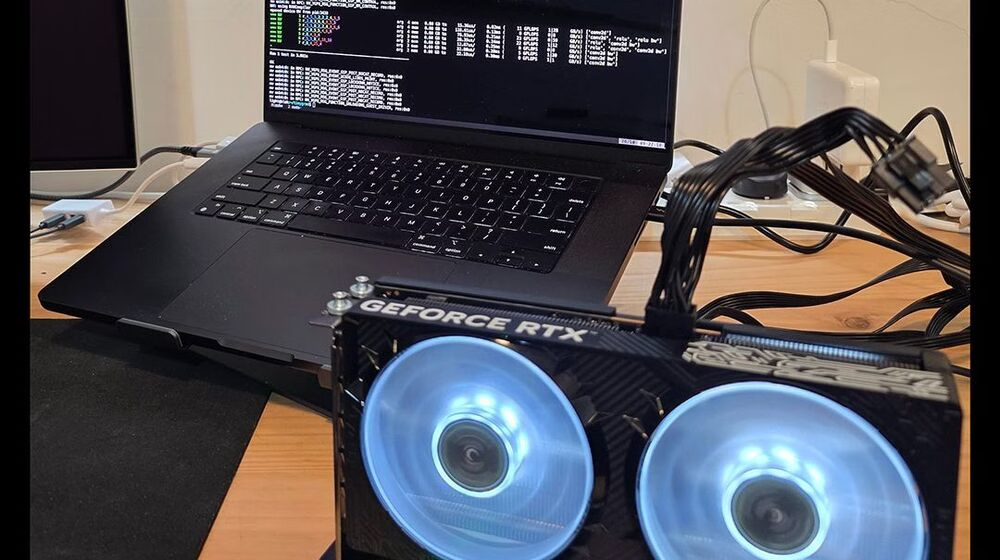In a remarkable technological breakthrough, TinyCorp has achieved what many developers and tech enthusiasts once thought impossible — Nvidia GPU support on MacBooks. The AI-focused startup has successfully made Nvidia’s RTX 30, 40, and even 50 series graphics cards compatible with MacBooks through USB4 and Thunderbolt 4 connectivity. This advancement opens new possibilities for AI developers using Apple’s ARM-based laptops, though it currently comes with certain limitations.
A Major Step for AI Development on Mac
TinyCorp shared the results of its experiment on X (formerly Twitter), demonstrating a MacBook Pro M3 Max running Tinygrad — the company’s open-source AI framework — while connected to an RTX GPU through an ADT-UT3G dock using USB4. This demonstration confirmed that Nvidia GPU support on MacBooks is not just theoretical but fully functional in a development context.
While this new driver enables AI workloads and GPU-based computing, it does not yet support display output. In other words, MacBooks won’t be able to use these external GPUs for gaming or rendering visuals — the current functionality is strictly focused on computation, particularly for AI training and data processing.
Compatibility and Hardware Details
TinyCorp confirmed that its new driver supports Nvidia RTX 30, 40, and 50 series GPUs. Early testing suggests that even some RTX 20 series cards may work with extra configuration steps, though this is not officially guaranteed. The startup emphasized that GTX-series cards are excluded since their architecture lacks a dedicated GPU system processor required for this integration.
Interestingly, TinyCorp also reported that AMD GPUs from the RDNA 2, 3, and 4 families are compatible with its framework. This makes the system highly versatile for developers who want to experiment with different GPU brands and performance configurations on Apple Silicon devices.
Why This Matters for Apple’s M-Series Devices
Ever since Apple transitioned from Intel-based processors to its proprietary M-series chips, Nvidia GPU support on MacBooks has been virtually non-existent. Apple’s ecosystem relies on its integrated GPUs, which are optimized for efficiency but not designed for large-scale AI workloads or external GPU processing.
TinyCorp’s achievement marks a significant turning point. By enabling external Nvidia GPU connectivity through Thunderbolt 4 and USB4, AI developers using Apple devices can now harness the power of high-end GPUs for tasks like neural network training, deep learning model development, and advanced data computation — areas where integrated GPUs typically struggle.
The Technical Foundation: USB4 and Thunderbolt 4
The success of this project lies heavily in the enhanced capabilities of USB4 and Thunderbolt 4. These standards provide native PCIe connectivity — a crucial component for connecting external GPUs to laptops. Compared to older USB3 ports, USB4 and Thunderbolt 4 offer dramatically higher bandwidth, enabling smooth data transfer between the MacBook’s M-series chip and the external Nvidia GPU.
TinyCorp had already gained experience working with AMD GPUs over USB3, which laid the groundwork for this new implementation. Building on that foundation, the company leveraged the increased data throughput and PCIe compatibility of USB4 to finally make Nvidia GPU support on MacBooks a reality.
Limitations: No Display Output Yet
Despite this exciting progress, there are still notable limitations. The most significant is the lack of display output functionality. The drivers currently allow the MacBook to recognize and utilize the GPU for computation, but users cannot connect an external monitor to the Nvidia GPU for visual rendering.
This limitation stems from Apple’s architecture — its M-series chips are designed with integrated graphics and have no native support for external display output from eGPUs. For now, the solution is purely for AI developers and researchers who need extra GPU power for machine learning or computation-heavy tasks, not for gaming or video editing.
What This Means for Developers
For AI developers, TinyCorp’s innovation represents a game-changing step. MacBooks, known for their efficiency and reliability, can now double as capable AI development machines when paired with external Nvidia GPUs. This makes it possible for developers to train complex AI models directly on macOS without switching to Windows or Linux-based systems.
The flexibility to use both Nvidia and AMD GPUs gives developers more freedom to choose hardware according to their workload needs and budget. With future driver updates, TinyCorp aims to further optimize performance and possibly expand support for more GPU features.
Although this is an early-stage development, TinyCorp’s success in achieving Nvidia GPU support on MacBooks could influence broader adoption of eGPU technology in Apple’s ecosystem. If Apple or third-party developers continue to refine such solutions, future updates might even introduce limited display support, making MacBooks more versatile for creative and technical professionals alike.
For now, TinyCorp’s breakthrough stands as a milestone in the field of AI computing and hardware innovation. It showcases the potential of combining Apple’s powerful M-series processors with Nvidia’s world-leading GPUs — a combination that could redefine how developers approach AI workflows on macOS systems.
Nvidia GPU support on MacBooks is no longer just a dream. TinyCorp’s achievement marks a pivotal moment for the AI and developer community, unlocking new possibilities for high-performance computing on Apple devices. While there are still hurdles to overcome — particularly regarding display functionality — the ability to harness external Nvidia GPUs via USB4 and Thunderbolt 4 is a revolutionary step forward.
This innovation not only bridges the gap between Apple and Nvidia ecosystems but also sets the stage for the next generation of AI development on macOS, blending power, portability, and progress like never before.



